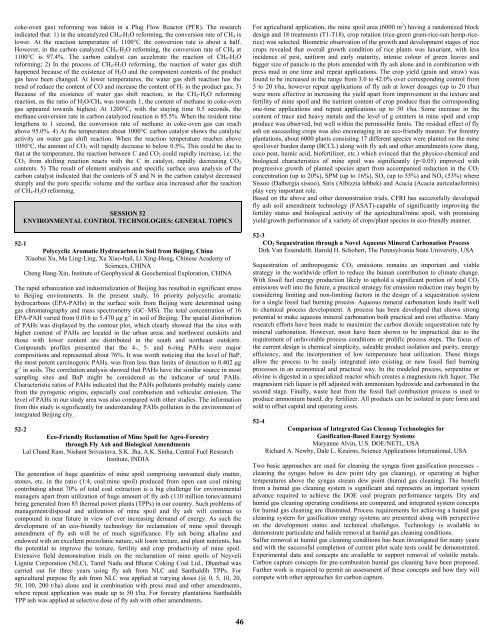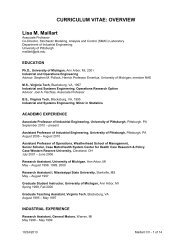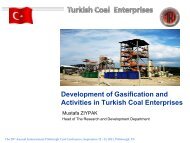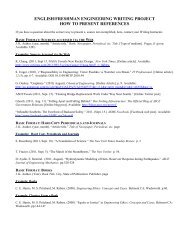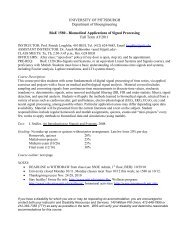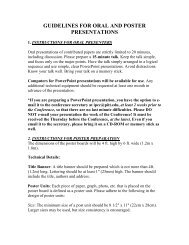Abstract Booklet 2006 - Swanson School of Engineering - University ...
Abstract Booklet 2006 - Swanson School of Engineering - University ...
Abstract Booklet 2006 - Swanson School of Engineering - University ...
You also want an ePaper? Increase the reach of your titles
YUMPU automatically turns print PDFs into web optimized ePapers that Google loves.
coke-oven gas) reforming was taken in a Plug Flow Reactor (PFR). The research<br />
indicated that: 1) in the uncatalyzed CH 4 -H 2 O reforming, the conversion rate <strong>of</strong> CH 4 is<br />
lower. At the reaction temperature <strong>of</strong> 1100°C the conversion rate is about a half.<br />
However, in the carbon catalyzed CH 4 -H 2 O reforming, the conversion rate <strong>of</strong> CH 4 at<br />
1100°C is 97.4%. The carbon catalyst can accelerate the reaction <strong>of</strong> CH 4 -H 2 O<br />
reforming; 2) In the process <strong>of</strong> CH 4 -H 2 O reforming, the reaction <strong>of</strong> water gas shift<br />
happened because <strong>of</strong> the existence <strong>of</strong> H 2 O and the component contents <strong>of</strong> the product<br />
gas have been changed. At lower temperatures, the water gas shift reaction has the<br />
trend <strong>of</strong> reduce the content <strong>of</strong> CO and increase the content <strong>of</strong> H 2 in the product gas; 3)<br />
Because <strong>of</strong> the existence <strong>of</strong> water gas shift reaction, in the CH 4 -H 2 O reforming<br />
reaction, as the ratio <strong>of</strong> H 2 O/CH 4 was towards 1, the content <strong>of</strong> methane in coke-oven<br />
gas appeared towards highest; At 1200°C, with the staying time 0.5 seconds, the<br />
methane conversion rate in carbon catalyzed reaction is 85.5%. When the resident time<br />
lengthens to 1 second, the conversion rate <strong>of</strong> methane in coke-oven gas can reach<br />
above 95.0%. 4) At the temperature about 1000°C carbon catalyst shows the catalytic<br />
activity on water gas shift reaction. When the reaction temperature reaches above<br />
1050°C, the amount <strong>of</strong> CO 2 will rapidly decrease to below 0.5%. This could be due to<br />
that at the temperature, the reaction between C and CO 2 could rapidly increase, i.e. the<br />
CO 2 from shifting reaction reacts with the C in catalyst, rapidly decreasing CO 2<br />
contents. 5) The result <strong>of</strong> element analysis and specific surface area analysis <strong>of</strong> the<br />
carbon catalyst indicated that the contents <strong>of</strong> S and N in the carbon catalyst decreased<br />
sharply and the pore specific volume and the surface area increased after the reaction<br />
<strong>of</strong> CH 4 -H 2 O reforming.<br />
SESSION 52<br />
ENVIRONMENTAL CONTROL TECHNOLOGIES: GENERAL TOPICS<br />
52-1<br />
Polycyclic Aromatic Hydrocarbon in Soil from Beijing, China<br />
Xiaobai Xu, Ma Ling-Ling, Xu Xiao-bail, Li Xing-Hong, Chinese Academy <strong>of</strong><br />
Sciences, CHINA<br />
Cheng Hang-Xin, Institute <strong>of</strong> Geophysical & Geochemical Exploration, CHINA<br />
The rapid urbanization and industrialization <strong>of</strong> Beijing has resulted in significant stress<br />
to Beijing environments. In the present study, 16 priority polycyclic aromatic<br />
hydrocarbons (EPA-PAHs) in the surface soils from Beijing were determined using<br />
gas chromatography and mass spectrometry (GC–MS). The total concentration <strong>of</strong> 16<br />
EPA-PAH varied from 0.016 to 5.470 μg g -1 in soil <strong>of</strong> Beijing. The spatial distribution<br />
<strong>of</strong> PAHs was displayed by the contour plot, which clearly showed that the sites with<br />
higher content <strong>of</strong> PAHs are located in the urban areas and northwest outskirts and<br />
those with lower content are distributed in the south and northeast outskirts.<br />
Compounds pr<strong>of</strong>iles presented that the 4-, 5- and 6-ring PAHs were major<br />
compositions and represented about 76%. It was worth noticing that the level <strong>of</strong> BaP,<br />
the most potent carcinogenic PAHs, was from less than limits <strong>of</strong> detection to 0.402 μg<br />
g -1 in soils. The correlation analysis showed that PAHs have the similar source in most<br />
sampling sites and BaP might be considered as the indicator <strong>of</strong> total PAHs.<br />
Characteristic ratios <strong>of</strong> PAHs indicated that the PAHs pollutants probably mainly came<br />
from the pyrogenic origins, especially coal combustion and vehicular emission. The<br />
level <strong>of</strong> PAHs in our study area was also compared with other studies. The information<br />
from this study is significantly for understanding PAHs pollution in the environment <strong>of</strong><br />
integrated Beijing city.<br />
52-2<br />
Eco-Friendly Reclamation <strong>of</strong> Mine Spoil for Agro-Forestry<br />
through Fly Ash and Biological Amendments<br />
Lal Chand Ram, Nishant Srivastava, S.K. Jha, A.K. Sinha, Central Fuel Research<br />
Institute, INDIA<br />
The generation <strong>of</strong> huge quantities <strong>of</strong> mine spoil comprising unwanted shaly matter,<br />
stones, etc. in the ratio (1:4, coal:mine spoil) produced from open cast coal mining<br />
contributing about 70% <strong>of</strong> total coal extraction is a big challenge for environmental<br />
managers apart from utilization <strong>of</strong> huge amount <strong>of</strong> fly ash (110 million tones/annum)<br />
being generated from 85 thermal power plants (TPPs) in our country. Such problems <strong>of</strong><br />
management/disposal and utilization <strong>of</strong> mine spoil and fly ash will continue to<br />
compound in near future in view <strong>of</strong> ever increasing demand <strong>of</strong> energy. As such the<br />
development <strong>of</strong> an eco-friendly technology for reclamation <strong>of</strong> mine spoil through<br />
amendment <strong>of</strong> fly ash will be <strong>of</strong> much significance. Fly ash being alkaline and<br />
endowed with an excellent pozzolanic nature, silt loam texture, and plant nutrients, has<br />
the potential to improve the texture, fertility and crop productivity <strong>of</strong> mine spoil.<br />
Extensive field demonstration trials on the reclamation <strong>of</strong> mine spoils <strong>of</strong> Neyveli<br />
Lignite Corporation (NLC), Tamil Nadu and Bharat Coking Coal Ltd., Dhanbad was<br />
carried out for three years using fly ash from NLC and Santhaldih TPPs. For<br />
agricultural purpose fly ash from NLC was applied at varying doses (@ 0, 5, 10, 20,<br />
50, 100, 200 t/ha) alone and in combination with press mud and other amendments,<br />
where repeat application was made up to 50 t/ha. For forestry plantations Santhaldih<br />
TPP ash was applied at selective dose <strong>of</strong> fly ash with other amendments.<br />
For agricultural application, the mine spoil area (6000 m 2 ) having a randomized block<br />
design and 18 treatments (T1-T18), crop rotation (rice-green gram-rice-sun hemp-ricerice)<br />
was selected. Biometric observation <strong>of</strong> the growth and development stages <strong>of</strong> rice<br />
crops revealed that overall growth condition <strong>of</strong> rice plants was luxuriant, with less<br />
incidence <strong>of</strong> pest, uniform and early maturity, intense colour <strong>of</strong> green leaves and<br />
bigger size <strong>of</strong> panicle in the plots amended with fly ash alone and in combination with<br />
press mud in one time and repeat applications. The crop yield (grain and straw) was<br />
found to be increased in the range from 3.0 to 42.0% over corresponding control from<br />
5 to 20 t/ha, however repeat applications <strong>of</strong> fly ash at lower dosages (up to 20 t/ha)<br />
were more effective in increasing the yield apart from improvement in the texture and<br />
fertility <strong>of</strong> mine spoil and the nutrient content <strong>of</strong> crop produce than the corresponding<br />
one-time applications and repeat applications up to 50 t/ha. Some increase in the<br />
content <strong>of</strong> trace and heavy metals and the level <strong>of</strong> g emitters in mine spoil and crop<br />
produce was observed, but well within the permissible limits. The residual effect <strong>of</strong> fly<br />
ash on succeeding crops was also encouraging in an eco-friendly manner. For forestry<br />
plantations, about 6000 plants consisting 17 different species were planted on the mine<br />
spoil/over burden dump (BCCL) along with fly ash and other amendments (cow dung,<br />
coco peat, humic acid, bi<strong>of</strong>ertilizer, etc.) which evinced that the physico-chemical and<br />
biological characteristics <strong>of</strong> mine spoil was significantly (p


